Barcelona – Roma 6:1
Barcelona came into this Champions League fixture off the back of one of the club’s most memorable performances in the modern era. Could they repeat the magnificent display they provided at the Bernabeu? Well, the result wasn’t as significant, even though it put them through in first place to the last 16 of the Champions League, but the performance was just as scintillating at times.
Roma meanwhile had a chance to give themselves a huge boost towards their goal of qualifying for the knockout stages. Rudi Garcia’s catastrophic defensive strategy quickly put this chance to move themselves well ahead of group rivals Bayer Leverkusen and BATE Borisov.
Both coaches named full strength sides with Vermaelen replacing Mascherano being the only forced short-term compromise having to be made by either coach. Enrique also gave Iniesta a much deserved rest, fielding Sergi Roberto instead.
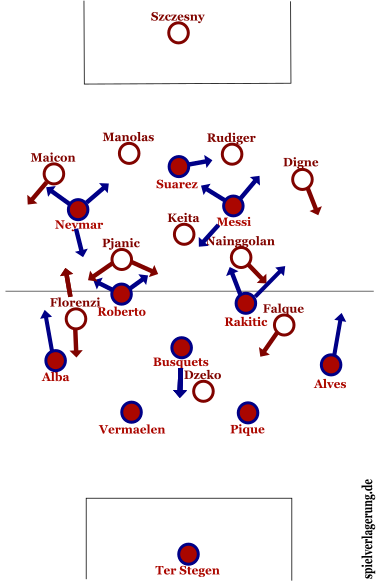
The line-ups. Barcelona in their 4-3-3 shape with Roma playing something in between a 4-3-3 and a 4-5-1.
Roma’s Dire Defence
The most obvious and important tactical oddity of this match was Roma’s defensive shape. They played a very, very high defensive line however a deeper midfield line, playing with great vertical compactness and no space whatsoever between the defence and midfield. They played with a degree of man-orientation all over the pitch however Roberto and Rakitic were specifically man-marked by Nainggolan and Pjanic respectively. This seemed strange as even though Barca’s #8s are key to pivoting deep build up into final third penetration however Roma’s high line meant that Barca could often skip out this midfield stage whatsoever. Also, of all the players to man-mark on the field, Roberto and Rakitic provide less threat than some of Barca’s other players.
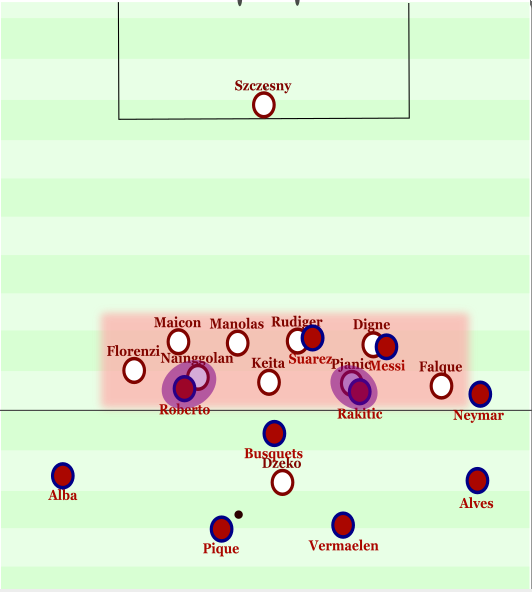
Roma’s vertically compact defensive shape with a high defensive line and man-marking of Roberto and Rakitic.
Playing a high defensive line although very risky against a team with the ball-playing ability of Barcelona, is a completely feasible strategy. The reason for the Roma’s defensive disaster wasn’t the high line alone, it was the high line combined with the fact that they didn’t press Barca’s middle-third possession at all. The whole point of playing a high line is to facilitate midfield and forward pressing without leaving huge gaps between lines, without this the high line serves no purpose other than being useful to deploy an offside trap which worked variably for Roma. Roma did manage to catch Barcelona offside 9 times however it only took 15 minutes for the offside trap to fail, and Barca to go 1-0 up. Also, Szczesny is notoriously calamitous when coming out of his 6-yard box and didn’t hold a high enough position or come out quick enough to sweep any potential balls in behind.
I am speculating that Roma did this to restrict Barca’s infamous midfield play. However, the space in between the centre-backs and central midfielders isn’t as vital to protect vs Barcelona as it used to be due to Messi not playing at false 9 any more. As I have mentioned, Barcelona are far more versatile than Roma gave them credit for and found it easy to shift the ball amongst the centre-backs and Busquets to open up spaces in Roma’s compact defence and then thread balls through into the huge space behind the defence. Their first goal demonstrated this:
Roma have created a situational back six as Rakitic has been followed by Nainggolan and Florenzi has dropped back on the right. Roma’s back line has pretty good spatial compactness as well as good coverage of wide areas. Notice Messi’s position, typical of Messi in his roaming role he has been playing in this year.
Neymar has dropped back to receive the ball. If the final ball is going to be a long one, then you don’t need numerous players on the last line. Barcelona have huge control in the box outlined above, and this is all that is needed to shift the ball around, finding gaps in the opposition defence to thread a ball through. Notice how having dangerous players such as Messi in this area of the field has pulled Nainggolan out of the defensive line. This, combined with Maicon following Neymar deeper, has meant that Roma’s situational back four now have very poor horizontal compactness.
Rakitic pulls back to make an option for Neymar, and Digne follows him, creating the space for Neymar to thread a ball through the halfspace to his Brazil teammate Dani Alves who sets up Suarez. Notice Barca’s juego de posicion structure of each CB and #8 in the halfspaces, the fullbacks on the flank, and the diamond of Neymar, Messi, Busquets and Suarez in the centre. Movements by Neymar into the halfspace and centre were very common against Roma, he normally spends most of the match in the left flank or halfspace and the left central midfielder will take up a position centrally. This structure gives an equal spread of players on each side of the pitch, making it difficult to maintain a horizontally compact defensive shape against, especially with Roma’s high degree of man orientation.
In the second half, Roma changed their approach, bringing Iturbe on for Nainggolan at half-time and defending in a 4-4-2 shape. This shape was slightly deeper with more space in between the lines and a bit more pressure on the ball at times. This was more of an effective strategy as Barca’s second half goals and key chances mostly came from situations where Roma were defending in their own third. Despite their man orientation, they allowed Suarez to drop off the defensive line and play similar balls to Messi for the 2nd and 4th of Barcelona’s goals.
Barca style of play-a combination of skill and structure
The secret to Barcelona’s entertaining and effective style in possession is threefold: a proficient (although sometimes inconsistent) positional structure; a quick passing tempo in middle third possession and even quicker in the final third; and immense individual skills and qualitative superiority of their attacking players. Since the Guardiola era the first of these has probably become worse, the second is about the same, although sometimes better, however the final one of these three has proved.
The trio of Messi, Neymar and Suarez played brilliantly in Messi’s first start since September 26th. Probably their best ever passage of play together was Barcelona’s second goal. Below shows barcelona’s left side overload in the build up to the goal.
Barca have overloaded the left side of the field, something which Messi’s roaming role facilitates well. Neymar and Alba are both positioned on the left flank, meaning Florenzi cannot get tight to either of them or he risks leaving the other free. Playing any sort of possession-based football requires many triangles and rhombuses all over the field of play, and Barca have a particularly star-studded rhombus above. This meant that as soon as Neymar receive the pass from Vermaelen, he had a plethora of immediate options. He played a one-two with Messi, then passed it back to Messi who played a one-two with Suarez and Barca scored.
Neymar and Messi’s role which allows them to come very deep in possession is very compatible with their abilities as players. Both, especially Messi, are brilliant passers and could find long passes behind the opposition defence which were so key in this match. Also, both players’ main strength is superb ball control at speed. Starting deep allows them to make a pass forward and then run forward to join the play, meaning they are already moving at a high pace when they receive the ball. This is similar to a runningback in American Football receiving from the quarterback while he is already moving at speed, meaning he has more chance of weaving through the defensive line.
Roma’s attacking strategy
Similar to their defensive strategy, Roma’s attacking play was rather unorthodox of a side playing at the Nou Camp. They committed lots of men up the field when they won the ball and looked to play a few short passes before a longer ball to find the space in behind the Barcelona defence. They looked to occupy the Barcelona defenders, placing three or four men on Barcelona’s defensive line in the first half, which increased to four or five following Iturbe’s introduction at the start of the second half.
In the example above we can see Roma occupying Barcelona’s back four while having Digne pushed up high on the left. Manolas is on the ball and Florenzi drops, knowing that Barcelona’s employ situational man-marking when tracking dropping players. Florenzi dumps the ball to Pjanic who can look up and find a pass to Digne. This passing angle has opened up due to Barcelona’s defence shifting to their left to fill the gap Alba has left.
In terms of selection, Dzeko wasn’t an ideal centre-forward to be playing at the Camp Nou. Although he scored his fourth goal in four Roma games and was the only centre-forward Garcia had at his disposal, the ideal forward to be playing against Barcelona is somebody who can press and someone who is quick on the counter attack. Playing a hold-up player such as Dzeko for the counter attack is fine however when he received the ball in the counter attack, Roma’s quick wingers were often too deep or too far away from Dzeko for the counter to be effective. This was obviously due to Roma’s deep midfield line in the defensive phase. Iturbe made a difference when he came on at half-time. He showed a higher defensive work rate as well as giving Roma a bit of counterattack-ability.
Conclusion
Barcelona are playing some of the most exciting football of any team on the planet right now and are now staunch favourites for the Primera division title as well as showing that it isn’t unlikely that they will become the first ever team to successfully defend the Champions League. They are even better than they were in their treble-winning campaign of last season. They have ironed out some of their structural deficiencies and their front three have now begun to develop a thorough understanding for one another on the football field.
Roma’s slightly kamikaze yet tactically flawed approach was certainly interesting to watch although it was not effective. They need to increase their depth of attacking options in January in order to survive in this competition should they qualify for the knock-out stages.
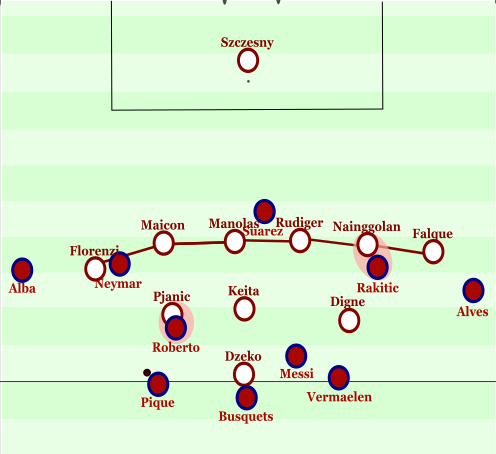
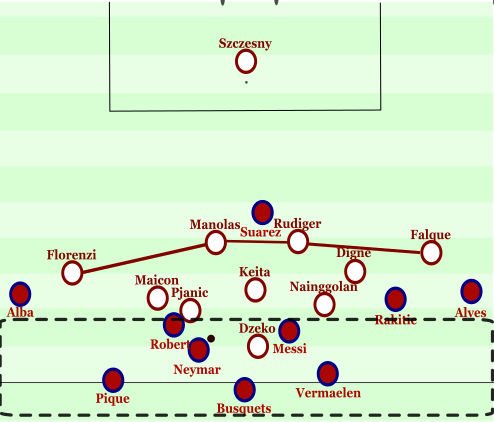
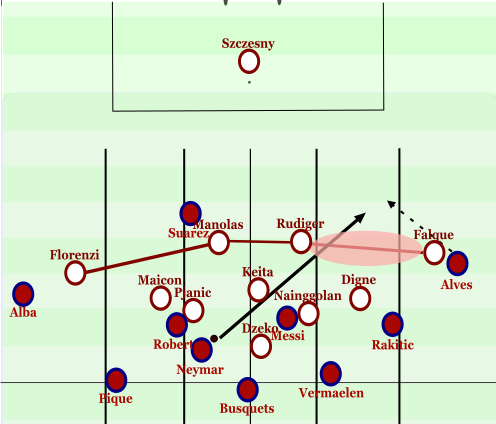

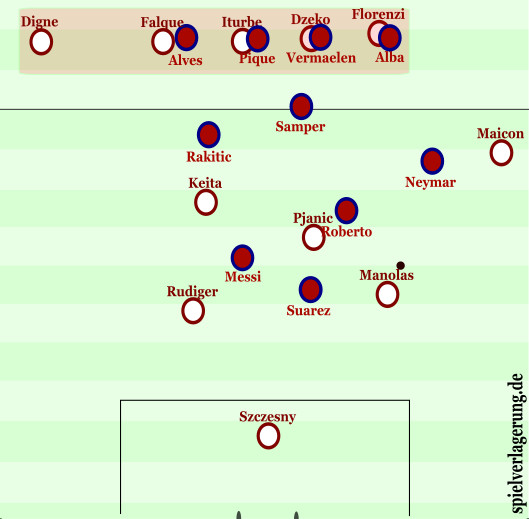
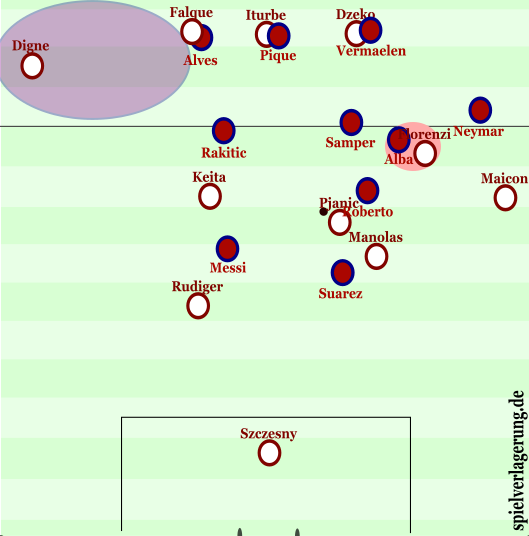
Keine Kommentare vorhanden Alle anzeigen